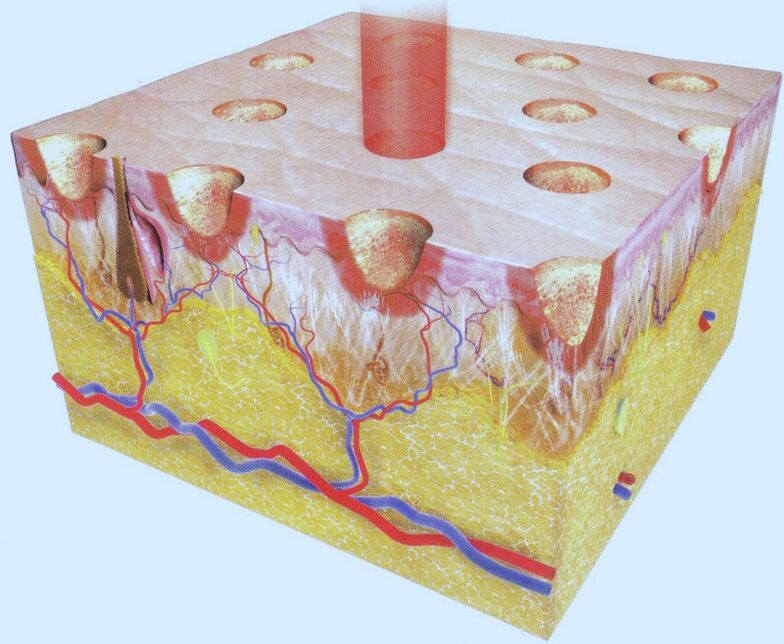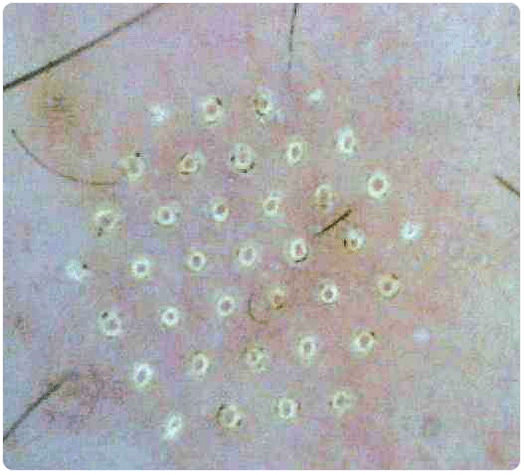
In modern medicine today, a huge number of hardware techniques and non-hardware procedures are used to solve the problems of young and old skin, but photo and elos rejuvenation procedures should not be confused with fractional rejuvenation - fractional thermolysis.
Fractional thermolysis is a controlled, efficient and safe way to rejuvenate, remove various cosmetic imperfections with a laser, suitable for both older and younger skin. During operation, the laser beam forms as thick as human hair. For a single flash of size 1-1, 5 cm2, the laser "pierces" many micro wounds (laser micro-cuts) on the skin. Around each of them, unaffected areas remain, and the damage caused by laser pulses stimulates the restoration of the skin structure on the entire treated surface.
Consider the technology itself. "Fractional" ablative (ablative) rejuvenation is in close interaction with "traditional", where fractional ablative (ablative) rejuvenation, due to its "spot" radiation, creates microthermal damage zones (MTZ), alternating with untreated tissue. Consequently, healing ismuch faster (only 1-2 days), which allows you to return to your usual lifestyle immediately.
The work of the laser is to destroy extremely small portions of old collagen and elastin, and the cells preserved around the affected areas "wake up" and begin to intensively reconstruct the damaged area. Recycled collagen and elastin, as well as other laser coagulated proteins in the affected area are involved in tissue regeneration. A new, functionally active skin is formed with all the properties of youthful skin.
The therapeutic effect is determined by the position of the microscopic areas on the skin.
Areas of exposure: face (including upper and lower eyelids, crows), forehead, eyebrow region, temporal region, cheeks, nose, nasolabial triangle, chin, neck, décolleté, arms, forearms, mammary glands, abdomen, back, thighs, gluteal regionand other areas.
Fractional thermolysis enables:
- achieve a rejuvenating effect on the skin of the face, neck, décolleté, back of the hand;
- remove wrinkles on the sensitive and sensitive area of the eyes ("crow's feet");
- eliminate age spots (increased pigmentation, melasma);
- significantly smooth, until complete disappearance, postoperative and traumatic (after cuts and burns) scars;
- fights stretch marks on the skin;
- correct the effects of acne (post-acne);
- decreased skin tone;
- an alternative to deep chemical peels.

How the procedure works. Before starting the treatment, the skin is cleansed with an antiseptic. The doctor sets the parameters needed in each case for the operation of the laser.
Fractional thermolysis is carried out directly with the help of a special extension, which enables maintaining the same distance from the "beginning" of the light beam to the skin.
During the session, the "flash" of the laser gives you a feeling that can be compared to the feeling of tingling. The procedure ends with the application of a nourishing, soothing cream.
The duration of the session and the number of procedures depends on the area of the treated area and the problem to be solved.
After the procedure, the rehabilitation period is minimal. The rapid process of reepithelialization ensures the restoration of the epidermal barrier, reduction of erythema and immediate clinical results ("tightening" of the tissue due to selective parameters of thermal radiation). The tissue reaction in the form of mild edema and redness of the skin lasts one to two days. The peeling that is natural after this procedure is eliminated with a light peeling and moisturizing cream.
In order for the rehabilitation period to pass without complications, and the result for a long time, it is necessary to follow all the instructions of the doctor for the care of delicate skin at home!
Contraindications for fractional thermolysis
- Pregnancy.
- Epilepsy.
- Oncological diseases.
- Acute inflammatory skin diseases.
- Herpes in the active phase;
- Psoriasis.
- Atopic dermatitis in the acute phase.
- Inflammatory processes in the area of the proposed treatment.
- If less than 2 weeks have passed after chemical peels and similar procedures.
- If less than 2 weeks have passed since the last sunbathing.
























